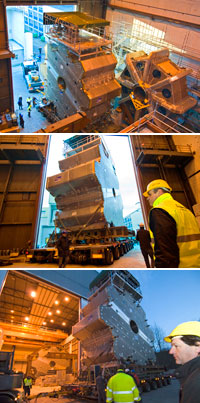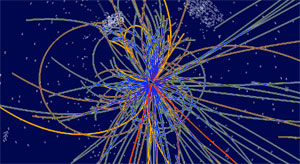
Bigger is better if you�re searching for smaller
Slowly –very slowly– a 1900-tonne mass of steel and wires descends like a sinking sun beneath the floor through a vertical tunnel (see photos above). The gigantic piece, weighing as much as 5 jumbo jets is 17 metres wide, leaving a mere 20 centimetres of clearance on either side. And this is just one section of the CMS detector being assembled underground.

Only two weeks earlier, a 5-story-tall magnet shaped like a giant cogwheel was wheeled out of its lair in one of the construction buildings on site, to begin the trek that will end this summer in a similarly spectacular descent into a tight space underground in the ATLAS cavern (see photos left). Another magnet just like it will follow a few weeks later.
With installation of the four enormous CERN detectors well underway, and the last of the 1600 magnets being put into place, the Movement of Big Things at CERN is at the forefront of everyone’s consciousness. There are just a few months to go before the biggest particle accelerator in the world smashes its first protons together; eventually it will do so with enough energy to create particles that will teach us about the very fabric of our cosmos. But surrounded as we are by these huge, delicate machines, one cannot help but wonder: why do they have to be so big?
When you want to take a picture of Mont Blanc, you whip out your cell phone and press 'take'. When you want to take a picture of an elementary particle, you whip out your 12-thousand-tonne particle detector, bury it a hundred metres underground, and turn on your custom-built 27-kilometre-long 14-TeV particle accelerator. Then you press 'take'. Why does looking for something so small it has no dimensions require you to build something seven stories tall and half as wide as a football field?
 The particles that physicists are looking for may be small, but they are hard to catch. Their high energy allows them to travel a long distance, even through dense materials, before they are stopped by something; some of them can shoot through a metre of lead as if it were empty space. The detectors must be large enough to catch these particles, and they must be dense enough to stop them so that they can be detected. The more you can learn about the particles you catch, the more accurately you can reconstruct what happened when the collision occurred at the centre of your detector.
The particles that physicists are looking for may be small, but they are hard to catch. Their high energy allows them to travel a long distance, even through dense materials, before they are stopped by something; some of them can shoot through a metre of lead as if it were empty space. The detectors must be large enough to catch these particles, and they must be dense enough to stop them so that they can be detected. The more you can learn about the particles you catch, the more accurately you can reconstruct what happened when the collision occurred at the centre of your detector.
The 'pictures' we get will teach us a great deal about how our universe works at the most fundamental level – and they may even be good enough for a postcard!
28 February 2007
